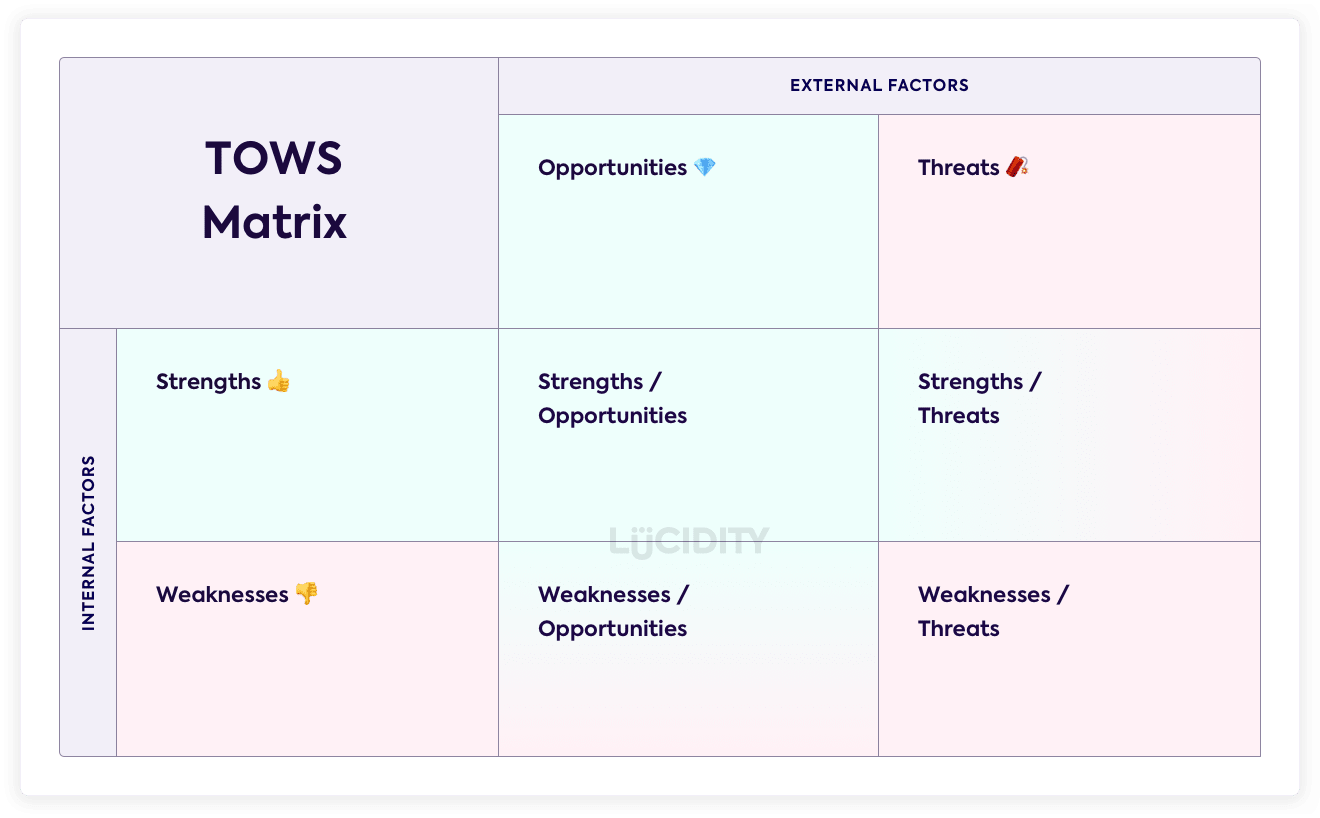Sometimes a TOWS Analysis can be confused as a different way to complete a SWOT, but it’s actually a different tool. It just happens to share the same focus areas of Strengths, Weaknesses Opportunities and Threats.
A TOWS Analysis is a great tool for both companies and departments, so let’s take a look and learn more…
What is a TOWS Analysis?
A TOWS Analysis is an extension of the SWOT Analysis framework that identifies your Strengths, Weaknesses, Opportunities and Threats but then goes further in looking to match up the Strengths with Opportunities and the Threats with Weaknesses. It’s a great next step after completing your SWOT and allows for you to take action from the analysis.
Adding the relationship between the internal and external factors makes TOWS a much more useful matrix than a standalone SWOT and an obvious next step. The main purpose of a TOWS Analysis is to:
- Reduce threats
- Take advantage of opportunities
- Exploit strengths
- Remove weaknesses
A well thought out TOWS can not only provide you with detail of your SWOT, but also some data to make a decision about your overall direction.
What is the difference between SWOT and TOWS?
The big difference between a TOWS and a SWOT is the relationships between the internal and external factors, examining how they link up, impact and influence each other…
Strengths to Opportunities:
The S-O focuses around how you can exploit your strengths in order to respond to the potential opportunities in the market.
Strengths to Threats:
The S-T examines how strengths can be used to mitigate or remove the threats to the business, and in some cases look at how threats can be transformed to opportunities.
Weaknesses to Opportunities:
The W-O can be the hardest consideration, as it doesn’t always come naturally. Consider how your opportunities can remove your weaknesses.
Weaknesses to Threats:
The W-T highlights how weaknesses can play into, develop or enhance the threats of the business.
What are the advantages of TOWS?
TOWS has a number of advantages:
- It’s simple to understand and complete
- It provides a good analysis of both internal and external issues
- It focuses on the positive and negative
- It leads to actions to improve your current position
What are some of the limitations of TOWS?
The limitations of TOWS are:
- It can be too broad to be used to make decisions
- It doesn’t contain a way to weight the importance or the element of risk
- It takes longer to complete than other frameworks
- You need a good knowledge of both internal and external issues to complete it
How do you make the most out of TOWS?
You may not have heard of TOWS before, whereas SWOT is likely to be something you’ve heard of a number of times. TOWS is worth researching as the outcome is usually more helpful than a SWOT, which on it’s own normally requires other frameworks to progress.
Before you start your TOWS:
- Gather feedback from your customers
- Talk to your employees and get their thoughts
- Always be honest and factual in the TOWS – remember it’s an internal tool
What preparation should be done before a TOWS?
While no preparation is required for a TOWS beyond some knowledge of the internal and external environment you operate in, it is helpful to have knowledge of:
- Current customer relationships
- Good & bad case studies of sales & service
- Latest news in your industry
- Any competitive activity
- Any M&A in the market
- Positive & negative employee feedback
If you’re running TOWS in a group, share this information via email beforehand.
Who invented TOWS?
TOWS was published in a paper called The TOWS Matrix A Tool for Situational Analysis by Heinz Weirich in 1982.
What’s the best way to run a TOWS session?
TOWS works best when done in a group of people from across your business. Ideally you need a mix of employees with different experiences and market knowledge to ensure you capture all aspects of the business.
How often is TOWS updated?
TOWS should be reviewed alongside your strategy at least on a quarterly basis, particularly as with TOWS you are assessing the relationship between the different internal and external aspects of your business. If you’ve updated your SWOT as a separate framework then it makes sense to update TOWS at the same time.
Check out our guide to completing a TOWS as a great next step or the Ultimate Guide to SWOT Analysis!














